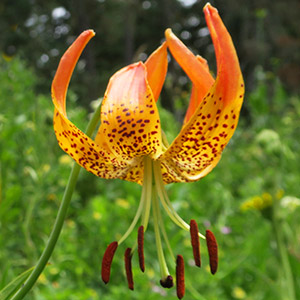Lilium pardalinum
leopard lily
in 1–8 whorls or sometimes scattered, 4–27 cm, generally elliptic; less often linear;
margin generally not wavy.
flowers 1–28(35), pendent.
more or less widely bell-shaped, generally not fragrant;
perianth segments 3.4–6.1(7.1)cm;
distal 67–75% potion reflexed, generally 2-toned;
inner surface generally pale orange to red on distal 25–60% portion; lighter near base; maroon spots (if near tip) margined yellow or orange;
outer surface paler and green on basal 20% portion;
stamens longer than perianth;
filaments spreading more or less widely;
anthers 5–22 mm; magenta to orange or yellow, becoming darker;
pollen red-brown to yellow, becoming lighter;
pistil 3–7.6 cm.
2.3–6 cm.
=24.
Lilium pardalinum
California and southwestern Oregon. 5 subspecies; 4 subspecies in Oregon.
The subspecies of Lilium pardalinum display a classic pattern of discrete geographical ranges with intervening zones of introgression, and no two occur sympatrically without intermixing. Plants in the hybrid zones are confusing in appearance and cannot readily be assigned to subspecies; however, each is fairly well marked within its core distribution. L. pardalinum subspecies in Oregon can be fairly common plants in the proper habitats within their rather narrow distributions, but since all are restricted to wetlands of one type or another, distribution is never continuous across the landscape. In introgression zones, plants often show indicators of genetic instability that include flowers lacking stamens or with shrunken and deformed anthers, filaments, or even petals. Leaf size and shape are quite variable in Lilium pardalinum subspecies and often clearly dependent on environment. In species or populations that typically have narrow, ascending leaves, for example L. pardalinum ssp. vollmeri, shaded plants often have wide, horizontal leaves. This hampers taxonomic separation as well as identification, especially of herbarium specimens. In addition to flower size, color, and habitat, anther size and the degree of stamen exsertion and spread are helpful characters for subspecies identification. Lilium pardalinum is primarily pollinated by western tiger swallowtails and pale swallowtails; in Oregon, Anna’s and rufous hummingbirds are also important visitors, especially when butterflies are rare. Native Americans reportedly ate Lilium pardalinum bulbs steamed or baked in an earth oven (Moerman 1986).
Mark Skinner



